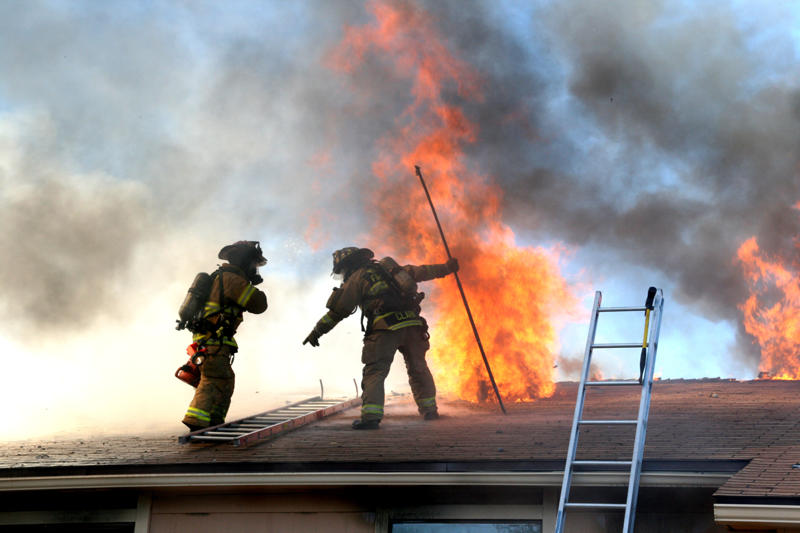California has been under a state of emergency since January 2014 due to the worst drought in the state’s history. With such low rainfall, grass and brush across California are tinder-dry and serve as perfect kindling for wildfires. The drought has enhanced the potential severity and fire risk this season and taking proactive steps around your home is essential to protecting both your own property and your community. Reducing wildfire risk factors is a collective effort and part of our civic responsibility as Californians. We are all in this together. With that said, let’s discuss some of the ways you can do your part to help prevent the spread of wildfires.
1. Create 100 feet of defensible space
Defensible space is the buffer zone between your home and a potential fire that firefighters need to protect your structure. The state of California suggests this buffer zone be at least 100 feet so firetrucks and personnel can get between your home and the fire and keep it at bay. Defensible space should be clear of all dried grass, trees and shrubbery and empty enough for firefighters to maneuver through if need be. This space slows the growth of the fire by depriving it of fuel and gives firefighters the space they need to fight back.
2. Do not landscape, Xeriscape!
Xeriscaping (“Xeri” is Greek for “dry”) is landscaping with native, drought-tolerant plants, and grasses that require little to no irrigation or maintenance. We recommended avoiding a traditional lawn in order to conserve water and money by using drought-resistant land cover instead. Plants that thrive in arid, desert conditions will also thrive here in California, particularly as low levels of rainfall persist.
3. Class up your home’s roof
If you are in a high fire-prone area (most of California), you should consider investing in a Class A fire-rated roof. Most modern roofs today have a Class A fire rating, so if you are unsure, you may want to speak with a local roofing company about your current roof. The classification system was developed by Underwriters Laboratories (UL) Inc. to test the resistance of roofing materials against burning embers, or brands as they’re called in the industry. During wildfires, burning embers sail through the air and a Class A roof is far less likely to catch fire when exposed to these embers.
4. Protect the interior
Drought conditions remind us of the exterior risks, but many fires start on the inside of homes and spread outdoors quickly if they are not contained. Cooking accidents are the most common cause of house fires, so it’s wise to invest in a few fire extinguishers and store them throughout your home, particularly in vulnerable areas like the kitchen. Be as alert as possible about turning off the stove, oven and other heat sources after you finish using them and letting pots and pans cool before removing them from the stovetop.
5. Install smoke detectors and replace the batteries
Most fatal fires occur at night. It’s crucial that you have a reliable fire detection system to warn you of smoke and fire. Install smoke and gas leak detectors in all sleeping rooms, hallways that lead to sleeping areas, basements, and each additional level of your home or apartment. Do not overlook the importance of gas leak detectors as undetected leaks can lead to devastating explosions. Several manufacturers now sell combination units that offer both smoke and gas leak detection features. Remember to replace the batteries twice a year. Some find it helpful to coordinate this with daylight savings and the changing of the clocks.
It is a simple, easy, and very important task to keep you, your family and your home safe. Detectors should be mounted on the ceiling 4” from the wall and wall mounts should be 4-12” from the ceiling. Do not install near draft areas (windows, vents, etc.) as this can minimize their effectiveness. Call your local fire department if you are unsure about detector placement.
6. Work in the yard when it is cool
Take advantage of cool days to tackle some of that yard work you have been avoiding. This is not just an issue of comfort. Using power tools outdoors during the heat of the day when it is dry, hot, and windy has a greater potential to spark a brushfire. It’s best to use such equipment early in the morning, preferably before 10 a.m. Installing a spark arrestor on your tools is also highly recommended.
7. Remove, reduce, and replace foliage around the house
Remove all dead plants, trees, and shrubs from around your home and if possible, your entire property. Reduce the amount of excess leaves, plant parts, and low-hanging branches by placing the dry refuse in a waste pile away from your home. Replace dense, flammable plants in close proximity to your home with more fire-resistant foliage. Plants should be no less than 3 feet from a structure, well watered, and maintained for the best results.
8. Clear your roof and gutters of debris
Trees drop leaves, branches, pinecones, and other debris onto your roof and they accumulate in the valleys and gutters over time. If possible, avoid going onto the roof on your own as it can be potentially dangerous to both you and your roof. Instead, hire a trusted professional with the right tools and safety equipment to clear your roof of fire hazard debris.
The accumulation of dry debris in your gutters also poses a potential threat for catching fire. Those wire-mesh screens advertised as the solution to gutter cleaning are not completely effective and will still require regular cleaning to avoid the accumulation of debris.The best option for keeping your gutters clean and safe is to hire a professional to clean both your roof and gutters before wildfire season begins.
If you have any further questions regarding how to best prepare your home for wildfire season or have recently been the victim of a fire and require restoration services, reach out to the fire damage experts at Mega Restoration. Contact us today!


